Meningkatkan Daya Saing UMKM melalui Penerapan Just-in-Time dan Teknologi Sederhana
Keywords:
Operational Efficiency, Cost Saving, Snack Food SMEs, Just-in-Time Production, Technological InnovationAbstract
Small and medium-sized enterprises (SMEs) in the snack food sector face challenges such as limited capital, fluctuating raw material prices and intense market competition. This article aims to identify operational efficiencies and cost saving strategies to improve business competitiveness and sustainability. Using Just-In-Time (JIT) and Lean Production approaches, SMEs can reduce waste, cut costs and improve productivity without compromising quality. The analysis focuses on gaps in the adoption of modern technology, resource management and collaboration with suppliers and customers. The methodology includes the evaluation of production efficiency concepts and demand-driven supply chain optimisation. This article offers solutions such as the use of simple automation technologies, such as packaging machines, and a collaborative approach to strengthening supply chain relationships. The contribution of the article is to provide practical guidelines that integrate efficiency strategies, technological innovation and risk management. The expected outcomes are that SMEs will be able to improve productivity, reduce operating costs and create sustainable business models. This approach provides opportunities for SMEs to remain competitive in dynamic markets while supporting local economic growth.
References
[1] F. Hanum, S. Yana, and P. Mauliza, Pemberdayaan Masyarakat Pedagang Kaki Lima dalam Meningkatkan Perekonomian. Mega Press Nusantara, 2024.
[2] J. A. Pineda Duque and S. E. Castiblanco Moreno, “Informal entrepreneurship and women’s empowerment–the case of street vendors in urban Colombia,” Int. J. Gend. Entrep., vol. 14, no. 2, pp. 188–212, 2022.
[3] S. E. Rizka, S. E. Nurfiani Syamsuddin, F. Arfan, and M. S. Abubakar, Membangkitkan Semangat Entrepreneurship Sejak Usia Dini: Kiat Sukses Dengan Semangat Nilai-Nilai Ke-Acehan; Edisi Pertama. Penerbit K-Media, 2021.
[4] Rafiki, Ahmad, Alfatih Gessan Pananjung, and Muhammad Dharma Tuah Putra Nasution, eds. Strategies and applications of islamic entrepreneurship. IGI Global, 2023.
[5] Q. H. Thai and K. N. Mai, “Does Entrepreneurial Financial Support Guarantee New Ventures’ Performance via Competitive Advantage and Innovation? Empirical Answers from Ho Chi Minh City Region, Vietnam,” Sustainability, vol. 15, no. 21, p. 15519, 2023.
[6] Naimah, Rahmatul Jannatin, et al. "Penerapan digital marketing sebagai strategi pemasaran UMKM." Jurnal IMPACT: Implementation and Action 2.2 (2020): 119-130.
[7] H. Indrawati, “How to maintain sustainability of micro and small entreprises of crispy oil palm mushroom: a case study in Riau Province,” J. Sci. Technol. Policy Manag., vol. 10, no. 2, pp. 431–456, 2019.
[8] S. A. Hendrawan, A. Chatra, N. Iman, S. Hidayatullah, and D. Suprayitno, “Digital transformation in MSMEs: Challenges and opportunities in technology management,” J. Inf. dan Teknol., pp. 141–149, 2024.
[9] R. Radhiana, “Peran Strategi Digital Marketing Dan Inovasi Proses Sebagai Upaya Peningkatan Daya Saing Produk Lokal Pada Perajin Anyaman Kulit Bak Bili Atau Pohon Bemban Di Aceh Besar,” JEMSI (Jurnal Ekon. Manajemen, dan Akuntansi), vol. 9, no. 3, pp. 967–977, 2023.
[10] S. Sriyanalugsana and K. Suwantararangsri, “The Key Development To Enhance Inventory Management For A New Insect Snack Food SME In Thailand,” Kasem Bundit Eng. J., vol. 10, no. 1, pp. 64–80, 2020.
[11] N. Nursini, “Micro, small, and medium enterprises (MSMEs) and poverty reduction: empirical evidence from Indonesia,” Dev. Stud. Res., vol. 7, no. 1, pp. 153–166, 2020.
[12] S. Mukherjee, “Challenges to Indian micro small scale and medium enterprises in the era of globalization,” J. Glob. Entrep. Res., vol. 8, pp. 1–19, 2018.
[13] A. S. Mawardi, “Analisis Pendekatan Lean Manufacturing Untuk Meminimasi Waste Pada Proses Produksi Fadhila Aqiqah Tasikmalaya.” Universitas Siliwangi, 2022.
[14] I. T. B. Widiwati, S. D. Liman, and F. Nurprihatin, “The implementation of Lean Six Sigma approach to minimize waste at a food manufacturing industry,” J. Eng. Res., 2024.
[15] J. Heizer, B. Render, and C. Munson, Operations management: sustainability and supply chain management. Pearson, 2020.
[16] M. P. Groover, Automation, production systems, and computer-integrated manufacturing. Pearson Education India, 2016.
[17] S. Bhat, E. V Gijo, A. M. Rego, and V. S. Bhat, “Lean Six Sigma competitiveness for micro, small and medium enterprises (MSME): an action research in the Indian context,” TQM J., vol. 33, no. 2, pp. 379–406, 2021.
[18] F. Lestari, “Penerapan Metode Economic Order Quantity dan Just in Time Guna Meningkatkan Optimasi Pengendalian Persediaan Produk,” J. Bisnisman Ris. Bisnis dan Manaj., vol. 5, no. 3, pp. 35–56, 2024.
[19] B. Jatmiko, U. Udin, R. Raharti, T. Laras, and K. F. Ardhi, “Strategies for MSMEs to achieve sustainable competitive advantage: The SWOT analysis method,” J. Asian Financ. Econ. Bus., vol. 8, no. 3, pp. 505–515, 2021.
[20] D. G. Caldwell, S. Davis, R. J. Moreno Masey, and J. O. Gray, “Automation in food processing,” Springer Handb. Autom., pp. 1041–1059, 2009.
[21] N. Slack, S. Chambers, and R. Johnston, Operations management. Pearson education, 2010.
[22] G. Singh and I. Singh Ahuja, “An evaluation of just in time (JIT) implementation on manufacturing performance in Indian industry,” J. asia Bus. Stud., vol. 8, no. 3, pp. 278–294, 2014.
[23] N. Kumar, A. Brint, E. Shi, A. Upadhyay, and X. Ruan, “Integrating sustainable supply chain practices with operational performance: an exploratory study of Chinese SMEs,” Prod. Plan. Control, vol. 30, no. 5–6, pp. 464–478, 2019.
[24] M. M. Jaza, M. I. Khoiruddin, R. N. Pinasty, I. N. Barira, and T. Adhitya, “Integrasi Kasir Pintar Untuk Peningkatan Daya Saing UMKM Warung Kuliner Dhoho Plaza Kota Kediri,” Welf. J. Pengabdi. Masy., vol. 2, no. 3, pp. 537–542, 2024.
[25] M. McDonald and H. Wilson, Marketing Plans: How to prepare them, how to profit from them. John Wiley & Sons, 2016.
[26] J. Ssebulime, “Budgeting and financial performance,” 2019.
[27] N. Culkin and R. Simmons, “Smaller Firms: Engines of Innovation,” in Mastering Brexits Through The Ages, Emerald Publishing Limited, 2018, pp. 43–92.
[28] P. Kotler, K. L. Keller, M. Brady, M. Goodman, and T. Hansen, Marketing Management 3rd edn PDF eBook. Pearson Higher Ed, 2016.
[29] J. Blythe, Consumer Behaviour: SAGE Publications. Sage, 2013.
[30] D. Pangestuti et al., “Rahasia Di Balik Kesuksesan: Strategi Cerdas UMKM Kuliner Dalam Mengelola Risiko,” Pengmasku, vol. 4, no. 1, pp. 25–37, 2024.
[31] D. I. Handayani, “A review: potensi risiko pada supply chain risk management,” Spektrum Ind., vol. 14, no. 1, p. 25, 2016.
[32] S. Sanusi, F. Fachruddin, I. Isfanda, C. Handriyani, and G. Rizki, “Edukasi Keamanan Pangan dan Digital Branding Produk UMKM Masyarakat Desa Langung Kabupaten Aceh Barat,” ABDIMASKU J. Pengabdi. Masy., vol. 7, no. 3, pp. 1031–1038, 2024.
[33] A. Putriana, A. Lase, S. Aisyah, and A. Lase, “Peran Quality Control terhadap Produk Usaha Chika Cake & Bakery di Kota Tarutung,” TOBA J. Tour. Hosp. Destin., vol. 2, no. 2, pp. 50–56, 2023.
[34] E. K. Mindarta, R. D. Bintara, A. Nyoto, F. I. Gunawan, G. Wulandari, and M. I. Effendi, “Teknologi Fryer And Oil Drainer Machine: Inovasi dalam Meningkatkan Produksi Kacang Telur di Desa Srigonco,” J. Hum. Educ., vol. 4, no. 5, pp. 1089–1099, 2024.
[35] I. S. Saguy and V. Sirotinskaya, “Challenges in exploiting open innovation’s full potential in the food industry with a focus on small and medium enterprises (SMEs),” Trends Food Sci. Technol., vol. 38, no. 2, pp. 136–148, 2014.
[36] A. J. Dewi, “Efektivitas Produksi Untuk Meningkatkan Penjualan Pada Usaha Mikro Kecil Menengah (UMKM) Keripik Tempe Dua Angsa Kecamatan Karanganyar Kebumen,” 2024.
[37] X. Liu et al., “Trends and challenges on fruit and vegetable processing: Insights into sustainable, traceable, precise, healthy, intelligent, personalized and local innovative food products,” Trends Food Sci. Technol., vol. 125, pp. 12–25, 2022.
[38] S. Ljasenko, N. Lohse, and L. Justham, “A comparison of the manufacturing resilience between fixed automation systems and mobile robots in large structure assembly,” Procedia Cirp, vol. 57, pp. 235–240, 2016.
Downloads
Published
Issue
Section
License
Copyright (c) 2024 Cut Rusmina, Mawardi (Author); M. Bakri, Susanti, Radhiana, Cut Aufal Surayya (Translator)

This work is licensed under a Creative Commons Attribution 4.0 International License.
















